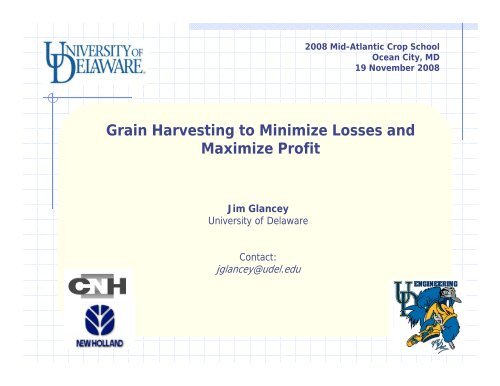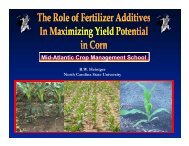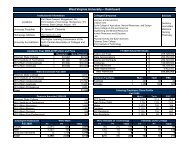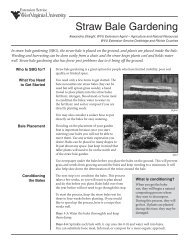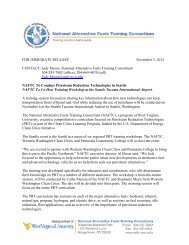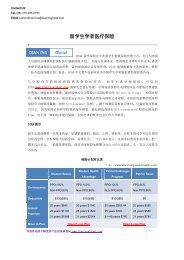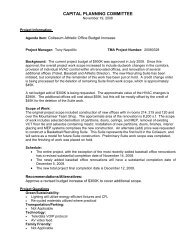Grain Harvesting to Minimize Losses and Maximize Profit Jim Glancey
Grain Harvesting to Minimize Losses and Maximize Profit Jim Glancey
Grain Harvesting to Minimize Losses and Maximize Profit Jim Glancey
You also want an ePaper? Increase the reach of your titles
YUMPU automatically turns print PDFs into web optimized ePapers that Google loves.
2008 Mid-Atlantic Crop School<br />
Ocean City, MD<br />
19 November 2008<br />
<strong>Grain</strong> <strong>Harvesting</strong> <strong>to</strong> <strong>Minimize</strong> <strong>Losses</strong> <strong>and</strong><br />
<strong>Maximize</strong> <strong>Profit</strong><br />
<strong>Jim</strong> <strong>Glancey</strong><br />
UUniversity i it of f Delaware D l<br />
Contact:<br />
jjglancey@udel.edu l @ d l d
PesentationO Presentation Overview e ie<br />
• Combines Currently on the Market<br />
• Harvest <strong>Losses</strong> <strong>and</strong> Costs<br />
• Combine Setup <strong>and</strong> Operation <strong>to</strong><br />
Reduce <strong>Losses</strong><br />
• Hardware Options<br />
• Safety
Ope Operation<br />
ation
<strong>Grain</strong> Separation <strong>and</strong> Cleaning<br />
Sieves Sieves
Combine Types<br />
CaseIH Axial Flow (Single Ro<strong>to</strong>r)
SSuper-conditioning pe conditioning
Combine Types<br />
New Holl<strong>and</strong> Twin Ro<strong>to</strong>r<br />
500+ hp
Combine Types<br />
John Deere CTS<br />
CTS (Cylinder Tine Separation):<br />
-66 cm diameter threshing cylinder<br />
-tine separation.<br />
-wet <strong>and</strong> green straw conditions.<br />
9780i CTS
Combine Types<br />
JJohn h Deere D WTS WTS<br />
WTS (Walker Tine Separation)<br />
-tine-separation<br />
-cylinder/walker machine.
Combine Types<br />
John h Deere STS S S<br />
SSTS S – Si Single l tine i separation<br />
i
Driving Fac<strong>to</strong>rs in Hay Drying<br />
(most important)<br />
(least important)
Corn Harvest Loss<br />
Survey of 65 Combines<br />
Frequency of Occurrence vs. Loss (bushels/acre)<br />
Cost:<br />
2.5 bushels<br />
@ $5.00/bu<br />
= $12.50<br />
or<br />
$1,250 per<br />
100 acres
Soybean Harvest Loss<br />
Survey of 83 Combines<br />
Frequency of Occurrence vs. Loss (bushels/acre)<br />
Cost:<br />
1.5 bushels<br />
@ $10.00/bu<br />
= $15/acre<br />
or<br />
$1,500 per<br />
100 acres
Volunteer beans in wheat after 2 bushels/acre harvest loss.
Whe Where e Field <strong>Losses</strong> Occ Occur<br />
Gathering<br />
75%<br />
Pre-harvest<br />
10%<br />
Separation<br />
15%
DDry Matte Matter Loss
Dry Matter<br />
Loss
<strong>Grain</strong> <strong>Harvesting</strong><br />
2008 Costs per acre<br />
Harveest<br />
Cost, $/acre $<br />
90<br />
80<br />
70<br />
60<br />
50<br />
40<br />
30<br />
20<br />
10<br />
Acres Harvested<br />
265hp & 66-row row<br />
305hp & 8-row<br />
385hp & 12-row<br />
0<br />
500 1000 1500 2000 2500<br />
Includes Combine, <strong>Grain</strong> Cart, <strong>and</strong> Hauling
<strong>Grain</strong> Carts<br />
2008 Costs<br />
Based on 1400 1 , 1900 2 <strong>and</strong> 2400 3 , acres respectively p y
Cus<strong>to</strong>m Combine Prices<br />
($/ ($/acre) )<br />
2008 2007<br />
• Corn Combining 28.40 27.60<br />
• Small <strong>Grain</strong>s 27.80 26.90<br />
• Soybeans 28.50 27.60<br />
• Hauling 0.20 0.18<br />
(per bushel)<br />
• Corn Drying y g (23%) ( ) 0.40 0.36<br />
(per bushel)
Checking Soybean Harvest Loss<br />
• Check an area a ea of ten<br />
square feet.<br />
• Approximately 45<br />
soybeans lost in this<br />
area will add up <strong>to</strong> one<br />
bushel per acre.<br />
• Make loss<br />
determinations at<br />
several locations <strong>and</strong><br />
calc calculate late an aaverage. e age
Checking Corn Harvest Loss<br />
• Check an area a ea of ten<br />
square feet.<br />
• Approximately 23<br />
kernels lost in this area<br />
willaddup<strong>to</strong>one<br />
will add up <strong>to</strong> one<br />
bushel per acre.<br />
• Make loss<br />
determinations at<br />
several locations <strong>and</strong><br />
calc calculate late an aaverage. e age
Checking Wheat Harvest Loss<br />
• Check an area a ea of one<br />
square feet.<br />
• Approximately 22<br />
kernels lost in this area<br />
willaddup<strong>to</strong>one<br />
will add up <strong>to</strong> one<br />
bushel per acre.<br />
• Make loss<br />
determinations at<br />
several locations <strong>and</strong><br />
calc calculate late an aaverage. e age
<strong>Harvesting</strong> Tips<br />
Soybeans Soybeans<br />
• Harvest soybeans y when pplants<br />
are mature <strong>and</strong> the<br />
beans have approximately 14% moisture.<br />
• Harvest may be started at 17 <strong>to</strong> 18% moisture when air<br />
drying g is available.<br />
• Harvest as much of the crop as possible above 12%<br />
moisture <strong>to</strong> avoid cracking seed coats <strong>and</strong> “splits.”<br />
• When soybean y seed is extremely y dry, y, (8 ( <strong>to</strong> 10 %<br />
moisture), harvesting will cause more shattering <strong>and</strong><br />
seed injury. Under these conditions, combine during<br />
morning or evening hours when relative humidity is<br />
hi higher h <strong>and</strong> d adjust dj t the th combine bi accordingly. di l<br />
• Adjust cylinder concave clearance according <strong>to</strong> the<br />
opera<strong>to</strong>r’s manual.<br />
• Wh When soybean b plants l <strong>and</strong> d pods d are <strong>to</strong>ugh, h cylinder li d<br />
speed may have <strong>to</strong> be increased.
<strong>Harvesting</strong> Tips<br />
Corn Corn Maturity Maturity <strong>and</strong> <strong>and</strong> Timing Timing<br />
• Corn reaches physiological p y g maturity y when the kernel<br />
black layer forms at the tip of kernels, <strong>and</strong> kernel<br />
moisture is about 30%.<br />
• As a general g rule in our northern corn growing g g region, g<br />
grain corn is usually ll physiologically h l ll mature<br />
approximately 50 <strong>to</strong> 55 days after the mid-silking date,<br />
<strong>and</strong> fairly safe from a killing frost.<br />
• If corn iis mid-silk id ilk on August A t 1, 1 then th it would ld be b safe f<br />
from damaging frost on Sept. 20 or by Sept. 25<br />
depending on maturity.<br />
• CCool l August A t days d <strong>and</strong> d nights i ht can further f th delay d l the th<br />
maturing process.<br />
• Optimum harvest moisture is 18-23%. S<strong>to</strong>rage moisture<br />
should be 15% short-term, short term <strong>and</strong> 13% or less long long-term.<br />
term
<strong>Harvesting</strong> Tips<br />
Small Small <strong>Grain</strong>s <strong>Grain</strong>s<br />
• Hot dry conditions result in shattering <strong>and</strong><br />
potentially severe yield loss when mature wheat<br />
st<strong>and</strong>s in the field.<br />
• <strong>Harvesting</strong> after rains significantly reduces header<br />
losses.<br />
• Make sure that knife sections, guards, g wear plates p<br />
<strong>and</strong> hold-down clips are in good condition <strong>and</strong><br />
properly adjusted.<br />
• Use a ground speed of 22.8 8 <strong>to</strong> 33.0 0 miles per hour hour.<br />
Use a reel speed about 25 percent faster than<br />
ground speed.
Combine Hardware Options
Stripper Headers?<br />
$37 $37,000<br />
000
Stripper Headers?<br />
Loss vs. Speed<br />
Loss vs. Wheat Yield
<strong>Grain</strong> Loss Moni<strong>to</strong>rs
Yield Moni<strong>to</strong>ring<br />
• Calibrate/Check for<br />
Accuracy<br />
• Every grain, every year<br />
• Use truck weights g <strong>and</strong><br />
moistures<br />
• Maintenance<br />
•Clean<br />
• Mice damage <strong>to</strong> wires
Guidance<br />
• 1. DGPS<br />
Differential correction signal provided by free WAAS service.*<br />
Typical GPS accuracy: +/- 10 inches<br />
• 22. DGPS VBS (Virtual Base Station)<br />
Differential correction signal provided by OmniSTAR subscription.**<br />
Typical GPS accuracy: +/- 10 inches<br />
• 3. DGPS XP<br />
Differential correction signal provided by OmniSTAR subscription.**<br />
Typical GPS accuracy: +/- 3 <strong>to</strong> 5 inches<br />
• 4. DGPS HP (High Performance)<br />
Diff Differential ti l correction ti signal i l provided id d by b OmniSTAR O iSTAR subscription.**<br />
b i ti **<br />
Typical GPS accuracy: +/- 2 <strong>to</strong> 4 inches<br />
• 5. RTK (Real Time Kinematics)<br />
Differential correction signal provided by base station. station<br />
Typical GPS accuracy: +/- 1 inch<br />
• * WAAS covers USA <strong>and</strong> parts of Canada.<br />
WAAS covers USA <strong>and</strong> parts of Canada.<br />
** DGPS VBS, DGPS XP <strong>and</strong> DGPS HP available worldwide. Consult<br />
www.omnistar.com for coverage <strong>and</strong> availability.
Safety Issues
Opera<strong>to</strong>r Visibility
Visibility . . .
Over the Road Transport<br />
• Biggest risk <strong>to</strong> an owner<br />
opera<strong>to</strong>r<br />
• Traffic <strong>and</strong> high speeds!!<br />
• Use a header cart<br />
• EEscort t vehicle<br />
hi l
OOverall e all Summary S mma<br />
Average harvest losses exceed $1000<br />
per 100 acres for all crops<br />
Checking/measuring relatively simple<br />
In-cab adjustments of combine<br />
settings allow for real time changes<br />
<strong>Harvesting</strong> system costs exceed $30<br />
per acre for most Delmarva growers
Questions?<br />
jglancey@udel.edu


